| Article ID | Journal | Published Year | Pages | File Type |
|---|---|---|---|---|
| 1951639 | Biochimica et Biophysica Acta (BBA) - Molecular Cell Research | 2006 | 9 Pages |
Most secretory cells undergoing calcium-regulated exocytosis in response to cell surface receptor stimulation display a dense subplasmalemmal actin network, which is remodeled during the exocytotic process. This review summarizes new insights into the role of the cortical actin cytoskeleton in exocytosis. Many earlier findings support the actin–physical-barrier model whereby transient depolymerization of cortical actin filaments permits vesicles to gain access to their appropriate docking and fusion sites at the plasma membrane. On the other hand, data from our laboratory and others now indicate that actin polymerization also plays a positive role in the exocytotic process. Here, we discuss the potential functions attributed to the actin cytoskeleton at each major step of the exocytotic process, including recruitment, docking and fusion of secretory granules with the plasma membrane. Moreover, we present actin-binding proteins, which are likely to link actin organization to calcium signals along the exocytotic pathway. The results cited in this review are derived primarily from investigations of the adrenal medullary chromaffin cell, a cell model that is since many years a source of information concerning the molecular machinery underlying exocytosis.
